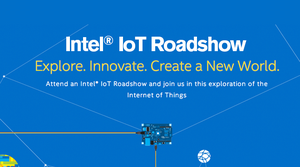
I called this technology Always On, because it works in the background and doesn't have to be turned on-and-off like a PC. I wrote about experiments using motes, sensors, and tiny processors affixed to products, or just strewn around the ground in order to study wildlife. Inventory solutions can find your keys with this technology, I wrote, and monitoring solutions can water your lawn. Health solutions can prevent heart attacks.
Many of these stories focused on Intel, which has now decided that the Internet of Things represents the future.
Over the last few months Intel began showing retail solutions that can measure customers for clothes at a glance and track clothes in stores. A computer-on-a-chip called Curie is being shown at fashion shows, used for health monitoring and CGI displays that take place around clothes. It’s the flash end of the market.
But Intel estimates that IoT already represents 4% of the company’s turnover. The big money is in industry, in turning an Inventory of Things into an Inventory of Systems that can control refineries, collecting big data used to improve production and prevent accidents. It you have ever wondered why there have been so few big planes going down over the U.S. lately, part of the answer lies in this technology, which constantly monitors a plane’s condition and alerts airlines to maintenance needs before conditions grow critical. IDC Research now sees this as a $1.7 trillion market within five years.
Standards are going to be vital in the IoT, to enable interoperability, and Intel is busy creating and negotiating such standards with software companies as well as carriers.
A lot of this market turns out to be in Asia, a market Intel failed to crack in its mobility quest. Asian companies can use IoT to help make factories run better, or to monitor both traffic and citizens.Security and privacy implications have many in the U.S. cool to this potential.
None of this has yet to hit Intel’s stock, which is down almost 17% over the last year as PC sales have slowed and the company’s efforts in mobile have continued to flounder. But Intel still brings 25% of its roughly $15 billion in sales to the net income line each quarter, its cash flow averages over $15 billion per year, and the balance sheet shows over $100 billion in assets with long-term debt that could be instantly repaid, in a crunch, using cash and short-term instruments in hand. Intel, in short, can be here for the long haul.
It’s not often that an investor gets a chance to get in on the “ground floor” of something while at the same time buy a 3.6% yield that can be covered by net income three times. It’s not often you can buy something with a Price/Earnings multiple below that of the market, a safe investment with speculation of leadership in a market niche that is about to explode, as in trillion-dollar explode.
But that is what Intel is looking at, today.
Things with intelligence are becoming parts of intelligent systems, and Intel is ahead of the pack facing this opportunity. Come for the dividend, stay for the speculation.










Curie was also featured in the recent ESPN X games, which show a new level of displaying data to the viewers.
Curie was also featured in the recent ESPN X games, which show a new level of displaying data to the viewers.
I love games very good blog thanks for sharing………………
I love games very good blog thanks for sharing………………